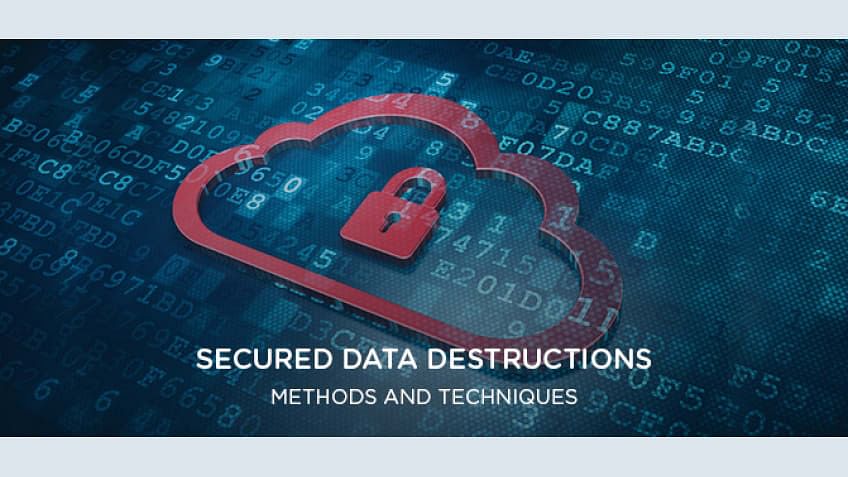Comprehending the Duty of Data Destruction in Fortifying Cyber Security Defenses
Comprehending the Duty of Data Destruction in Fortifying Cyber Security Defenses
Blog Article
Exploring the Importance of Data Destruction in the Context of Computer System Protection Providers and Protecting Confidential Information
In a period where information breaches are progressively common, the significance of effective information devastation can not be overemphasized. Organizations needs to embrace stringent steps to ensure that delicate details is not only secured throughout its lifecycle but also emphatically gotten rid of when no more needed. The approaches utilized for information elimination, coupled with conformity to legal standards, play a crucial role in keeping privacy and trust. Nonetheless, the ramifications of these techniques prolong past simple compliance, affecting a business's online reputation and operational honesty in the digital industry. What methods can organizations carry out to boost their data destruction procedures?
Understanding Data Damage
Information devastation is a vital part of computer system safety that involves the irreversible removal of data from storage space devices to protect against unapproved gain access to and prospective data violations. In a significantly digital landscape, organizations deal with increased threats linked with delicate information being improperly accessed or exploited. Efficient data damage safeguards against these dangers, making sure that personal dataâEUR" such as consumer details, intellectual residential property, and monetary recordsâEUR" can not be recuperated after disposal.
Comprehending the value of information damage prolongs past mere conformity with lawful and governing frameworks; it is necessary for preserving organizational stability and count on. When data is improperly taken care of or improperly ruined, the repercussions can be extreme, including financial loss, reputational damage, and lawful responsibilities.
Approaches of Data Obliteration

One common technique is information cleaning, which includes overwriting existing information with arbitrary patterns numerous times. This strategy provides the initial information irretrievable, making it a preferred selection for companies looking for to shield personal details.
Another approach is degaussing, which makes use of an effective electromagnetic field to interfere with the magnetic domain names on storage space gadgets, successfully eliminating the information. This technique is especially efficient for magnetic media however is not appropriate to solid-state drives.
Physical destruction is another robust approach, crushing or involving the shredding of storage tools. This method guarantees that information healing is essentially impossible, making it perfect for highly delicate details.
Finally, encryption can function as a corresponding method to data eradication. By securing data prior to removal, organizations can include an extra layer of safety, guaranteeing that also if remnants are recovered, they continue to be unattainable without the decryption key. Each approach ought to be picked based upon the level of information sensitivity and the details safety and security requirements of the company.
Legal Compliance and Information Safety And Security
Organizations must navigate a complex landscape of lawful requirements associated to data safety, particularly after implementing techniques of information removal. Numerous policies, such as the General Information Protection Guideline (GDPR) and the Medical Insurance Portability and Liability Act (HIPAA), enforce strict standards on how organizations have to get rid of and handle of delicate information. Failure to adhere to these laws can lead to considerable lawful repercussions, including significant fines and reputational damage.
Information devastation processes should be diligently documented to show conformity with applicable laws and requirements. This paperwork not just functions as evidence of adherence to legal responsibilities however additionally highlights a commitment to protecting sensitive info. Organizations needs to also establish clear policies concerning information retention and devastation timelines, ensuring that data is not held longer than necessary.

In addition, normal audits and analyses of information devastation methods are crucial to directory preserve compliance and adjust to advancing lawful frameworks (data destruction). By proactively dealing with legal needs, companies can reduce risks related to information breaches and demonstrate their dedication to data security. Inevitably, focusing on legal conformity in information destruction procedures is not just a regulatory obligation, yet an essential aspect of a durable data security approach
Effect on Business Online Reputation
The track record of a company can be significantly influenced by its technique to data devastation and administration. In today's electronic landscape, where data violations can happen anytime, the failure to appropriately throw away sensitive info can lead to serious consequences. Organizations that improperly handle data damage threat subjecting private consumer details, which not only breaches privacy regulations but additionally wears down depend on among clients and stakeholders.
A damaged credibility can result in decreased client loyalty, as clients end up being reluctant to engage with a company that has actually shown negligence in securing their information. Negative publicity surrounding a data breach can have an enduring impact, as possible consumers could be deterred by the perceived lack of security. This can result in a direct decline in revenue and market share.
Furthermore, companies that prioritize information devastation as component of their protection approach can boost their reputation by showcasing their commitment to safeguarding delicate details. By taking on rigid information administration methods, organizations can not only minimize threats however likewise position themselves as trustworthy entities in their respective sectors, consequently enhancing their general brand photo.

Ideal Practices for Secure Disposal
Applying finest practices for secure disposal of information is important for alleviating risks linked with data breaches and making sure compliance with personal privacy policies. Organizations should embrace an extensive information disposal policy that lays out procedures for both physical and electronic information damage.
For physical information storage tools, such as disk drives, shredding or degaussing is advised to stop information healing. Additionally, companies ought to maintain a chain of safekeeping documents during the disposal process, making certain responsibility and traceability of disposed items.
For digital information, utilizing software that abides by sector requirements for information wiping is essential. This software program should overwrite existing data several times, making recuperation practically difficult. It is additionally important check this to confirm the performance of the information destruction process with audits or third-party analyses.
Educating employees on protected disposal methods includes an additional layer of safety and security, content as human error can commonly bring about data exposure. On a regular basis reviewing and updating disposal plans makes certain alignment with evolving policies and technological innovations. By implementing these finest methods, companies can significantly reduce the danger of unapproved information access and improve their general data protection technique.
Final Thought
To conclude, data damage is a basic facet of computer system protection solutions that ensures the defense of secret information from unapproved gain access to. Carrying out efficient techniques of information elimination, sticking to lawful compliance, and acknowledging the influence on service reputation are essential components of an extensive data safety and security technique. By embracing best practices for secure disposal, organizations can cultivate trust fund with customers and guard delicate data, eventually contributing to a more secure electronic landscape.
In an age where data violations are progressively common, the value of efficient data devastation can not be overstated.Information damage is a vital component of computer system safety and security that entails the long-term elimination of information from storage tools to avoid unapproved gain access to and possible data breaches. Organizations must additionally develop clear policies relating to data retention and devastation timelines, making sure that data is not held longer than needed.
By proactively addressing legal requirements, organizations can minimize dangers linked with data breaches and show their commitment to information safety and security (data destruction). Inevitably, prioritizing legal conformity in data damage procedures is not just a regulatory responsibility, but a basic element of a durable data safety strategy
Report this page